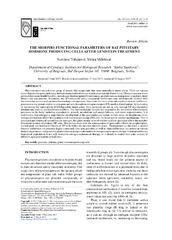Приказ основних података о документу
The Morpho-Functional Parameters of Rat Pituitary Hormone Producing Cells After Genistein Treatment
| dc.creator | Trifunović, Svetlana | |
| dc.creator | Milošević, Verica | |
| dc.date.accessioned | 2018-10-08T12:40:57Z | |
| dc.date.available | 2018-10-08T12:40:57Z | |
| dc.date.issued | 2018 | |
| dc.identifier.uri | http://www.degruyter.com/view/j/macvetrev.ahead-of-print/macvetrev-2017-0027/macvetrev-2017-0027.xml | |
| dc.identifier.uri | http://content.sciendo.com/view/journals/macvetrev/41/1/article-p5.xml | |
| dc.identifier.uri | https://radar.ibiss.bg.ac.rs/handle/123456789/3156 | |
| dc.description.abstract | Phytoestrogens are a diverse group of steroid–like compounds that occur naturally in many plants. There are various types of phytoestrogens, including the best-researched isoflavones which are commonly found in soy. The consumption of soy products has many health benefits, including protection against breast cancer, prostate cancer, menopausal symptoms, heart disease and osteoporosis. In contrast, use of hormonally active compounds-isoflavones may unfortunately interfere with the endocrine system and can have far-reaching consequences. Genistein, the most abundant soy-bean derived isoflavone, possesses a ring system similar to estrogens and acts through an estrogen receptor (ER)-mediated mechanism, by increasing or decreasing the transcription of ER-dependent target genes. Also, genistein can act on cells through ER non-dependent mechanisms, such as tyrosine kinase inhibitor. The neuroendocrine systems are responsible for the control of homeostatic processes in the body, including reproduction, growth, metabolism and energy balance, and stress responsiveness. It is well known, that estrogen is important for development of the neuroendocrine system in both sexes. At the pituitary level, estrogen is known to affect the regulation of all hormone producing (HP) cells, by direct and/or indirect mechanisms. Due to structural and functional resemblance to estrogen, the question may arise of whether and how genistein affects the morphofunctional features of pituitary HP cells. This review deals with the consequences of genistein’s effects on morphological, stereological and hormonal features of HP cells within the anterior pituitary gland. Transparency on this issue is needed because isoflavones are presently highly consumed. Inter alia, genistein as well as other isoflavones, are present in various dietary supplements and generally promoted as an accepted alternative to estrogen replacement therapy. Potential isoflavone biomedical exploitation is not only limited to estrogen replacement therapy, so it should be treated in a wider context of different ageing symptoms remediation. | en |
| dc.relation | info:eu-repo/grantAgreement/MESTD/Basic Research (BR or ON)/173009/RS// | |
| dc.rights | openAccess | |
| dc.rights.uri | https://creativecommons.org/licenses/by/4.0/ | |
| dc.source | Macedonian Veterinary Review | |
| dc.subject | Genistein | |
| dc.subject | Hormone producing cells | |
| dc.subject | Pituitary gland | |
| dc.title | The Morpho-Functional Parameters of Rat Pituitary Hormone Producing Cells After Genistein Treatment | en |
| dc.type | article | en |
| dc.rights.license | BY | |
| dcterms.abstract | Трифуновић, Светлана; Милошевић, Верица; | |
| dc.rights.holder | © 2017 Trifunović S. | |
| dc.citation.issue | 1 | |
| dc.citation.volume | 41 | |
| dc.identifier.doi | 10.1515/macvetrev-2017-0027 | |
| dc.identifier.scopus | 2-s2.0-85037837244 | |
| dc.citation.apa | Trifunović, S., & Milošević, V. (2018). The Morpho-Functional Parameters of Rat Pituitary Hormone Producing Cells After Genistein Treatment. Macedonian Veterinary Review, 41(1), 5–19. | |
| dc.citation.vancouver | Trifunović S, Milošević V. The Morpho-Functional Parameters of Rat Pituitary Hormone Producing Cells After Genistein Treatment. Maced Vet Rev. 2018;41(1):5–19. | |
| dc.citation.spage | 5 | |
| dc.citation.epage | 19 | |
| dc.type.version | publishedVersion | en |
| dc.identifier.fulltext | https://radar.ibiss.bg.ac.rs//bitstream/id/4528/MacedVetRev_2018_41_1_5-19.pdf |

